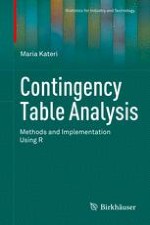2014 | OriginalPaper | Chapter
4. Log-Linear Models
Activate our intelligent search to find suitable subject content or patents.
Select sections of text to find matching patents with Artificial Intelligence. powered by
Select sections of text to find additional relevant content using AI-assisted search. powered by
Abstract
R and interpreted. Log-linear models for three-dimensional tables are illustrated through mosaic plots. Graphical models are shortly discussed. Finally the collapsibility in multi-way tables, in connection to Simpson’s paradox, is addressed.